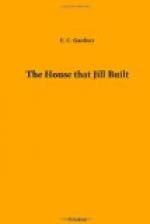The next morning, armed with a bundle of laths, sharpened at one end, and equipped with paper, pencil and tape-line, the prospective house-builders proceeded to lay out, not the house but the plan. They planted doors, windows, fireplaces and closets, stoves, lounges, easy-chairs and bedsteads, as if they were so many seeds that would grow up beside the laths on which their respective names were written and bear fruit each according to its kind. Later in the day a high step-ladder was introduced, from the top of which Jill scanned the surrounding country, while Jack stood ready to catch her if she fell. The neighbors were intensely interested, and their curiosity was mixed with indignation when, toward night, a man was discovered cutting down two of the rock-maple trees that Jill’s grandfather planted more than fifty years before, and which stood entirely beyond any possible location of the new house.
“This evening, Jack, you must write for the architect to come.”
“I thought you were going to make your own plans.”
“I have made them, or rather I have laid them out on the ground and in the air. I know what I want and how I want it. Now we must have every particular set down in black and white.”
Jack wrote accordingly. The architect was too busy to respond at once in person, but sent a letter referring to certain principles that reach somewhat below the lowest foundation-stones and above the tops of the tallest chimneys.
[Illustration]
CHAPTER II.
MORAL SUASION FOR MALARIAL MARSHES.
“You are quite right,” the architect wrote, “to fix the plan of your house on the lot before it is made on paper, provided first the lot is a good one. Nothing shows the innate perversity of mankind more forcibly than the average character of the sites chosen for human habitations in cities, in villages and in the open country. Or does it rather indicate the instinctive struggle for supremacy over nature? The ‘dear old nurse’ is most peaceably inclined toward us, yet we shall never be satisfied till all the valleys are exalted and the hills laid low. Not because we object to hills and valleys—quite the contrary; but we must show our strength and daring. Nobody wants the North Pole, but we are furious to have a breach made in the wall that surrounds it. If we discover a mighty primeval forest we straightway grind our axes to cut it down; an open prairie we plant with trees. When we find ourselves in an unclean, malarious bog, instead of taking the short cut out, shaking the mud from our feet and keeping clear of it forever after, we plunge in deeper still and swear by all the bones of our ancestors that we will not only walk through it dry-shod, but will build our homes in the midst of it and keep them clean and sweet and dry. The good mother beckons to us with her sunshine and whispers with her fragrant breezes that on the other side of the river or across the bay the land is high and dry, that just beyond the bluffs are the sunny slopes where she expected us to build our houses, and, like saucy children as we are, we say that is the very reason we prefer to go somewhere else.




